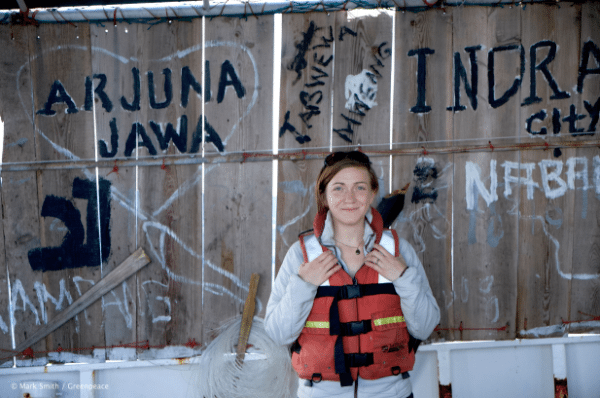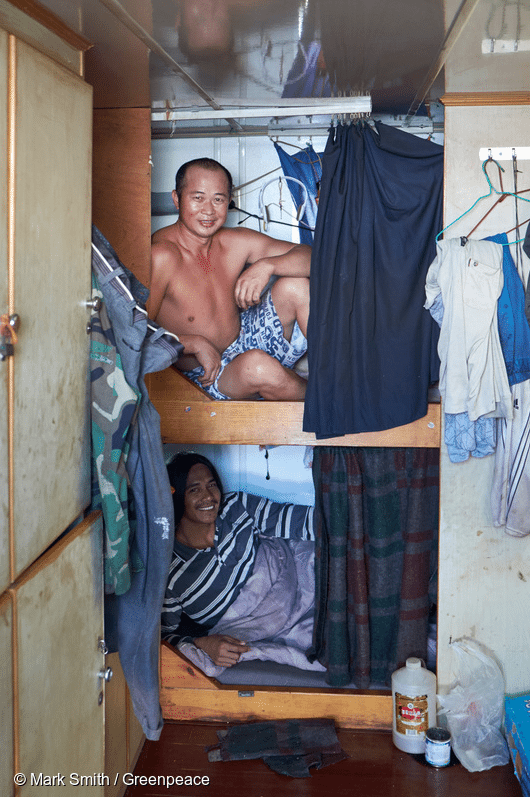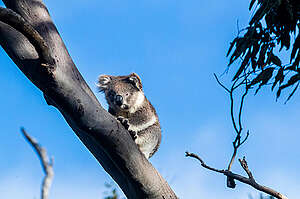Blogpost by Dawn Bickett – October 21, 2015 at 9:24
As a vegan, Dawn Bickett used to feel removed from the issue of sustainable seafood. But after documenting the Pacific tuna industry’s destructive ways with the Greenpeace Rainbow Warrior, she’s determined to do more to protect our oceans and those who rely on them.
This is her story.
Dong Yu 1518 was an isolated island in a watery world: a long-distance vessel that had been at sea for months fishing for tuna in the Pacific Ocean. And I was standing on its deck.
Just a week earlier, I had joined the Greenpeace ship Rainbow Warrior on its journey in the South Pacific. The ship was campaigning for change in the tuna fishing industry, which is infamous for overfishing, harm to marine life and labor abuse. Fishing vessels are rarely monitored — especially in international waters — so we were on the high seas to track down tuna ships and document their actions.
As excited as I was to join the crew and campaign at the frontlines of ocean destruction, it felt surreal to be in the middle of major fishing grounds. I haven’t eaten fish — or any animal — in well over a decade. I care about making seafood sustainable because I care about the health of the ocean ecosystem. But up until recently, it wasn’t personal. In my day-to-day, I rarely thought about seafood.
To me, I’d already done the biggest thing I could do to help fish in our ocean: I decided not to eat them.
“With or Without Me Eating Tuna, This Scene Had Played Itself Out for Years”
On the deck of the Dong Yu 1518, we Greenpeacers introduced ourselves to the crew. When we locked eyes, they seemed more than a bit surprised we were there. I was, too.
Being on that tuna vessel was like entering a completely different world — a grimy, rusty outpost in the Pacific. Bunks were squeezed into a couple of tiny rooms. I got the sense from the layout that the people on these ships were not the priority. They needed every square inch for tuna.
And I was struck by how far all of us were from home. Not just those of us on the Rainbow Warrior, but the vessel’s officers from China and the crew from Indonesia. They had travelled thousands of miles to chase one fish, their time at sea growing longer as tuna populations declined. The crew members were putting themselves at greater and greater risk — trusting they would get paid, trusting they would not be abused — because there was no way to back out if they changed their mind on the high seas. I looked around me: was this what they had signed up for?
We watched as a crew member opened the freezer hatch and clouds of vapor poured out. They had been at sea for months, so the massive freezer compartment was filled with many tons of frozen fish. As the crew transferred fish between freezers, it was hard for me to imagine that these three-foot frozen cylinders without fins or a tail had ever been alive. This was tuna?
Soon, my question was answered. The Greenpeace observer team stayed onboard as the crew hauled in their lines (this ship was a longliner). Within minutes, cries went up and a fisherman pulled an albacore on deck. It was beautiful. It was struggling for life. And the fishermen made short work of it; its blood sloshed back and forth on the deck with the waves. It was the first time I’d ever seen an animal slaughtered, and it was every bit as awful as I imagined.
As we left the Dong Yu 1518 and returned to the Rainbow Warrior, I realized that with or without me eating tuna, this scene had played itself out for years: the tuna being chased to the ends of the Earth, tuna fisherman living in harsh conditions at best, and facing forced labor at worst.
My choices alone weren’t enough. Something bigger needed to change.
Crew members sleep in tight quarters on the Dong Yu 1518.
After visiting more ships, the Rainbow Warrior headed to American Samoa, the end of my trip. The island was in crisis when we arrived. A local StarKist cannery — the largest private sector employer on the island — was considering closing. Tuna supplies were too low to make a profit, cannery officials argued.
It turned out that long distance fishing vessels like the one I visited on the high seas were a relatively new phenomenon. And they were chasing tuna that might otherwise have been caught in the coastal waters of Pacific Islands. So instead of local fishermen catching tuna, local governments regulating the fishing industry and the community profiting — fishing vessels were chasing tuna further and further out and catching more tuna than was sustainable. Meanwhile, Pacific islands like American Samoa, which relied economically and culturally on fishing in their waters, suffered.
It was clear that the ripple effects of this destructive industry spread across the Pacific, from Indonesia, to the Pacific Islands, to me in the United States. After all, stores where I shop and restaurants where I eat demand and sell tuna from the fishing grounds I was visiting.
“I Have More Power Than I Thought”
On the Pacific, I discovered that I was not an island. And neither was this ship I visited. My choice not to support industrial tuna with my dollars is still a valid one, but it isn’t enough to change an entire industry. It wasn’t helping to ensure that workers were safe, that these ships were regulated, or that American Samoa was able to benefit off the fish that had once been so numerous in its waters.
To make a difference for the people and the marine life I saw on the Rainbow Warrior, I need to do more than abstain from this exploitative system.
When I came home, my friends and family all wanted to hear about my adventure at sea. I told them about it, but I told them about tuna, too — the fishing companies that take workers and sustainability into account, and the ones that don’t. And I’m excited to pressure the stores where I buy food to make better choices when it comes to the seafood they sell.
I have far more power — and reason — to do something about the tuna industry than I thought. Now it’s up to me to use it.
Dawn Bickett is a content editor for the Americas at Greenpeace.



